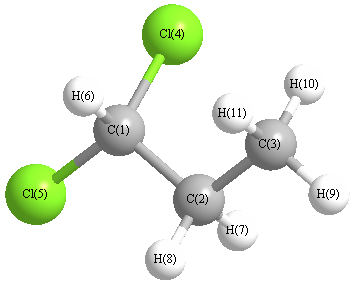Geometric Data

Point Group C1
Internal coordinates
distances (r) in Å, angles (a) in degrees, dihedrals (d) in degrees
| Description |
Value |
unc. |
Connectivity |
Reference |
Comment |
| Atom 1 |
Atom 2 |
Atom 3 |
Atom 4 |
Cartesians
Atom - Atom Distances 
Distances in Å
Calculated geometries
for CHCl
2CH
2CH
3 (1,1-dichloropropane).
Bond descriptions
Examples: C-C single bond, C=C, double bond, C#C triple bond, C:C aromatic bond
| Bond Type |
Count |
| C-C |
2 |
| H-C |
6 |
| C-Cl |
2 |
Connectivity
| Atom 1 |
Atom 2 |
| C1 |
C2 |
| C1 |
Cl4 |
| C1 |
Cl5 |
| C1 |
H6 |
| C2 |
C3 |
| C2 |
H7 |
| C2 |
H8 |
| C3 |
H9 |
| C3 |
H10 |
| C3 |
H11 |







